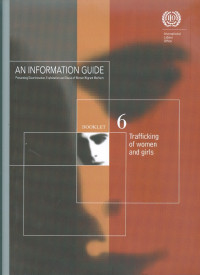
Text
Booklet 6 trafficking of women and girls
Because of the very nature of trafficking, there are no precise data available. Butrecent United States Government estimates 4 indicate that approximately 800,000 to 900,000 people annually are trafficked across international borders worldwide and between 18,000 and 20,000 of those victims are trafficked into the United States. Roughly 120,000 are trafficked into the European Union annually, mostly through the Balkans. 5 These estimates do not include internal trafficking. The evidence reveals an alarming increase in the incidence, severity and global reach of trafficking; the highly systematic nature and sophisticated mechanisms involved; the links with organized crime and official corruption; the varied purposes for which persons are trafficked; and the particularly exploitative and abusive effects of trafficking. Therefore, trafficking, especially in women and children for sexual exploitation and other forms of forced labour, has come high on the agenda of government and non-government actors worldwide: “Trafficking in persons is a particularly abusive form of migration. In the Millennium Declaration, States resolved to take measures to ensure respect for the protection of the rights of migrants and to intensify their efforts to fight trafficking […]. Urgent, effective and coherent action is therefore required. It is essential to recognize the complexities involved. Trafficking is not one single event, but a series of constitutive acts and circumstances involving a wide range of actors.Itis essentialthat anti-trafficking measures take account of this fact and that efforts are made to address the entire cycle of trafficking
Availability
| KP X.000135 | KP X LIM t | My Library | Available |
Detail Information
- Series Title
-
An information guide preventing discrimination, exploitation and abuse of women migrant workers
- Call Number
-
KP X LIM t
- Publisher
- Jenewa : International Labour Organization (ILO)., 2006
- Collation
-
113p. ; 29,5 cm.
- Language
-
Indonesia
- ISBN/ISSN
-
9221137635
- Classification
-
KP X
- Content Type
-
-
- Media Type
-
-
- Carrier Type
-
-
- Edition
-
-
- Subject(s)
- Specific Detail Info
-
-
- Statement of Responsibility
-
-
Other version/related
No other version available
File Attachment
Comments
You must be logged in to post a comment
 Computer Science, Information & General Works
Computer Science, Information & General Works  Philosophy & Psychology
Philosophy & Psychology  Religion
Religion  Social Sciences
Social Sciences  Language
Language  Pure Science
Pure Science  Applied Sciences
Applied Sciences  Art & Recreation
Art & Recreation  Literature
Literature  History & Geography
History & Geography